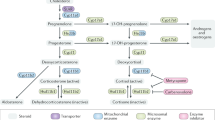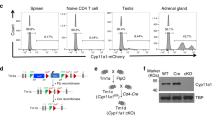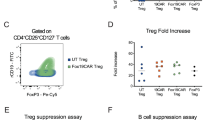Abstract
Glucocorticoids, acting through the glucocorticoid receptor, potently modulate immune function and are a mainstay of therapy for treatment of inflammatory conditions, autoimmune diseases, leukemias and lymphomas1. Moreover, removal of systemic glucocorticoids, by adrenalectomy in animal models or adrenal insufficiency in humans, has shown that endogenous glucocorticoid production is required for regulation of physiologic immune responses2. These effects have been attributed to suppression of cytokines, although the crucial cellular and molecular targets remain unknown3. In addition, considerable controversy remains as to whether glucocorticoids are required for thymocyte development4,5,6,7. To assess the role of the glucocorticoid receptor in immune system development and function, we generated T-cell-specific glucocorticoid receptor knockout mice. Here we show that the T-cell is a critical cellular target of glucocorticoid receptor signaling, as immune activation in these mice resulted in significant mortality. This lethal activation is rescued by cyclooxygenase-2 (COX-2) inhibition but not steroid administration or cytokine neutralization. These studies indicate that glucocorticoid receptor suppression of COX-2 is crucial for curtailing lethal immune activation, and suggest new therapeutic approaches for regulation of T-cell-mediated inflammatory diseases.
This is a preview of subscription content, access via your institution
Access options
Subscribe to this journal
Receive 12 print issues and online access
$209.00 per year
only $17.42 per issue
Buy this article
- Purchase on Springer Link
- Instant access to full article PDF
Prices may be subject to local taxes which are calculated during checkout



Similar content being viewed by others
References
Webster, J.I., Tonelli, L. & Sternberg, E.M. Neuroendocrine regulation of immunity. Annu. Rev. Immunol. 20, 125–163 (2002).
Bertini, R., Bianchi, M. & Ghezzi, P. Adrenalectomy sensitizes mice to the lethal effects of interleukin 1 and tumor necrosis factor. J. Exp. Med. 167, 1708–1712 (1988).
Winoto, A. & Littman, D.R. Nuclear hormone receptors in T lymphocytes. Cell 109, S57–S66 (2002).
Ashwell, J.D., Vacchio, M.S. & Galon, J. Do glucocorticoids participate in thymocyte development? Immunol. Today 21, 644–646 (2000).
Jondal, M., Pazirandeh, A. & Okret, S. A role for glucocorticoids in the thymus? Trends Immunol. 22, 185–186 (2001).
King, L.B. et al. A targeted glucocorticoid receptor antisense transgene increases thymocyte apoptosis and alters thymocyte development. Immunity 3, 647–656 (1995).
Purton, J.F., Boyd, R.L., Cole, T.J. & Godfrey, D.I. Intrathymic T cell development and selection proceeds normally in the absence of glucocorticoid receptor signaling. Immunity 13, 179–186 (2000).
Cole, T.J. et al. Targeted disruption of the glucocorticoid receptor gene blocks adrenergic chromaffin cell development and severely retards lung maturation. Gen. Dev. 9, 1608–1621 (1995).
Da Silva, J.A. Sex hormones and glucocorticoids: interactions with the immune system. Ann. N. Y. Acad. Sci. 876, 102–117 (1999).
Vacchio, M.S., Lee, J.Y. & Ashwell, J.D. Thymus-derived glucocorticoids set the thresholds for thymocyte selection by inhibiting TCR-mediated thymocyte activation. J. Immunol. 163, 1327–1333 (1999).
Scott, D.E., Gause, W.C., Finkelman, F.D. & Steinberg, A.D. Anti-CD3 antibody induces rapid expression of cytokine genes in vivo. J. Immunol. 145, 2183–2188 (1990).
Charpentier, B. et al. Evidence that antihuman tumor necrosis factor monoclonal antibody prevents OKT3-induced acute syndrome. Transplantation 54, 997–1002 (1992).
Ferran, C. et al. Reduction of morbidity and cytokine release in anti-CD3 MoAb-treated mice by corticosteroids. Transplantation 50, 642–648 (1990).
Franchimont, D. et al. Inhibition of Th1 immune response by glucocorticoids: dexamethasone selectively inhibits IL-12-induced Stat4 phosphorylation in T lymphocytes. J. Immunol. 164, 1768–1774 (2000).
Iniguez, M.A., Punzon, C. & Fresno, M. Induction of cyclooxygenase-2 on activated T lymphocytes: regulation of T cell activation by cyclooxygenase-2 inhibitors. J. Immunol. 163, 111–119 (1999).
Gross, G. et al. Inhibition of cyclooxygenase-2 prevents inflammation-mediated preterm labor in the mouse. Am. J. Physiol. Regul. Integr. Comp. Physiol. 278, R1415–R1423 (2000).
Penning, T.D. et al. Synthesis and biological evaluation of the 1,5-diarylpyrazole class of cyclooxygenase-2 inhibitors: identification of 4-[5-(4-methylphenyl)-3- (trifluoromethyl)-1H-pyrazol-1-yl]benze nesulfonamide (SC-58635, celecoxib). J. Med. Chem. 40, 1347–1365 (1997).
Li, H., Llera, A., Malchiodi, E.L. & Mariuzza, R.A. The structural basis of T cell activation by superantigens. Annu. Rev. Immunol. 17, 435–466 (1999).
Tanaka, K. et al. Cutting edge: differential production of prostaglandin D2 by human helper T cell subsets. J. Immunol. 164, 2277–2280 (2000).
Merger, M. et al. Defining the roles of perforin, Fas/FasL, and tumour necrosis factor alpha in T cell induced mucosal damage in the mouse intestine. Gut 51, 155–163 (2002).
Musch, M.W. et al. T cell activation causes diarrhea by increasing intestinal permeability and inhibiting epithelial Na+/K+-ATPase. J. Clin. Invest. 110, 1739–1747 (2002).
Bethin, K.E., Vogt, S.K. & Muglia, L.J. Interleukin-6 is an essential, corticotropin-releasing hormone-independent stimulator of the adrenal axis during immune system activation. Proc. Natl. Acad. Sci. USA 97, 9317–9322 (2000).
Muglia, L.J., Jenkins, N.A., Gilbert, D.J., Copeland, N.G. & Majzoub, J.A. Expression of the mouse corticotropin-releasing hormone gene in vivo and targeted inactivation in embryonic stem cells. J. Clin. Invest. 93, 2066–2072 (1994).
Muglia, L.J. et al. Corticotropin-releasing hormone links pituitary adrenocorticotropin gene expression and release during adrenal insufficiency. J. Clin. Invest. 105, 1269–1277 (2000).
Ferran, C. et al. Cascade modulation by anti-tumor necrosis factor monoclonal antibody of interferon-gamma, interleukin 3 and interleukin 6 release after triggering of the CD3/T cell receptor activation pathway. Eur. J. Immunol. 21, 2349–2353 (1991).
Acknowledgements
We thank E. Unanue, R. Schreiber and J. Gitlin for critical review of this manuscript; A. Cheng for insightful discussions and critical review of this manuscript; E. Plut, M. Wallace and the Washington University Mouse Genetics Core for embryonic stem cell injections; K. Hamilton and the Siteman Cancer Center Genechip Facility for microarray experimentation; K. Sheehan and R. Schreiber for providing neutralizing antibodies to IFN-γ; and Pharmacia Corporation for providing SC-236. This work was supported by grants from the National Institutes of Health and the Pharmacia–Washington University Biomedical Research Program (L.J.M.) and the Medical Scientist Training Program (J.A.B.).
Author information
Authors and Affiliations
Corresponding author
Ethics declarations
Competing interests
L.J.M. and B.P.S. received research support from Pharmacia Corp. as part of the Washington University/Pharmacia Biomedical Research Program. H.F. is employed Pharmacia Corp. (now part of Pfizer Inc.)
Rights and permissions
About this article
Cite this article
Brewer, J., Khor, B., Vogt, S. et al. T-cell glucocorticoid receptor is required to suppress COX-2-mediated lethal immune activation. Nat Med 9, 1318–1322 (2003). https://doi.org/10.1038/nm895
Received:
Accepted:
Published:
Issue Date:
DOI: https://doi.org/10.1038/nm895
This article is cited by
-
Revisiting steroidogenesis and its role in immune regulation with the advanced tools and technologies
Genes & Immunity (2021)
-
Glucocorticoids in T cell development, differentiation and function
Nature Reviews Immunology (2021)
-
Circadian glucocorticoid oscillations preserve a population of adult hippocampal neural stem cells in the aging brain
Molecular Psychiatry (2020)
-
Arthritis and the role of endogenous glucocorticoids
Bone Research (2020)
-
Control of immunity by glucocorticoids in health and disease
Seminars in Immunopathology (2020)



